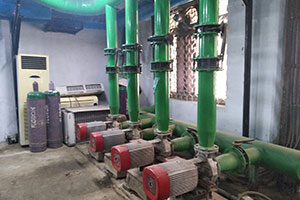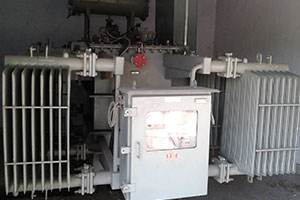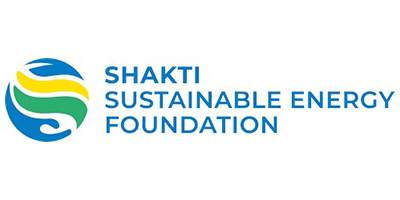Slash Your Energy Bill
-
Air Compressor System

Up to 40% energy can be saved by minimizing air leakages
Compressor room
- Locate the air compressor or your compressor room close to the point(s) of use.
- Make sure your compressor room is kept clean, dust-free and cool. You can save up to 3% of the energy used by your compressors!
- Do not expose compressors to sunlight. Also, isolate the compressors from other heat-producing equipment. Provide adequate ventilation.
Piping system
- Always install overhead compressed air pipelines. If you bury pipelines, you cannot spot leakages. Also, buried pipelines are difficult to repair or replace.
- Install low-friction pipelines to minimize pressure losses.
- Install separate lines for high pressure and low pressure.
- Take out branch lines from the top to avoid moisture carry-over.
- Avoid unnecessary bends and turns in the distribution network, as these will lead to pressure losses.
- Install ring main loop holder in distribution network, to minimize pressure loss.
- Install moisture separators to remove moisture from the air before it enters pneumatic equipment. Moisture separators may not be required if you have installed an air dryer.
Operation & Maintenance
- Use compressed air only when necessary. Keep the valves closed when not in use.
- Generate compressed air close to the required end-use pressure—because energy is wasted by compressing air to higher pressure than required! Maintain the pressure at not more than 0.5 kg/cm2 above the maximum requirement. Possible energy savings: 3–5%.
- Use dedicated air compressors to meet exclusive high or low pressure demands.
- For very low air pressure requirements, use nozzle-type spray guns.
- Use air blowers for high-volume, low-pressure compressed air applications such as to clean up mist or dust.
- Use air receiver to accommodate large volume of intermittent loads.
- Check for leakages—through joints, valves and bends. Conduct leakage test on a regular basis. Up to 40% energy can be saved by minimizing leakages.
- Clean the air filters periodically to ensure clean air intake. Accumulation of dirt increases the system resistance—and hence, energy consumption—lowering the efficiency of the compressor.
General
- Do you have fluctuating loads? If so, use variable frequency drives (VFDs) to save 10–40% energy. You may use one invertor-type air compressor to meet the variable load requirements, and the other compressors to meet base load.
- Invest in an energy efficient air compressor—because energy accounts for 75% of its life cycle cost while its capital cost (upfront investment) accounts for just 15%!
- Compressed air means energy and money! Use it wisely.
-
Cooling towers

- Monitor and record dry bulb temperature and wet bulb temperature on a regular basis.
- Install on-line temperature indicators to monitor and record inlet and outlet temperatures of water in the cooling tower.
- Maintain approach of the cooling tower about 4–5 °C (approach = cooling water supply temperature – ambient wet bulb temperature)
- Install automatic thermostatic controller for on–off control of cooling tower fans
- Install dedicated energy meter for cooling tower and record energy consumption on a daily basis.
- Carry out visual inspection of fills in cooling tower. Replace fills if required for uniform distribution of water.
- Use poly vinyl chloride (PVC) fills in place of wooden bars.
- Undertake regular checks of the cooling tower for dust and algae, and remove them if found to improve cooling effect.
- Treat the water chemically to minimize levels of micro-organisms.
- Ensure proper functioning of drift eliminators to control drift losses, which otherwise would require more fresh make-up water requiring pre-treatment before being taken to cooling tower well. Replace wooden drift eliminators with efficient PVC type drift eliminators.
- Measure water flow rate of each cooling tower on a daily basis. Add suitable quantity of make-up water to compensate for water losses due to evaporation, drift and blow-down.
- Install variable frequency drive (VFD) to optimize energy performance while catering to fluctuating process load.
- Do not use metal fans in the cooling tower. Replace metal fans with fibre reinforced plastic (FRP) type fans.
- Isolate redundant pipelines to avoid unnecessary water flow to process areas that are not in operation or use.
-
DG sets

- Install dedicated energy meters for DG sets.
- Record energy consumption and diesel consumption for each DG set to monitor specific electricity generation ratio (SEGR).
- Ensure proper functioning of injection pump and replace faulty nozzles to optimize fuel consumption.
- Clean air filters once in a month to avoid blockage.
- Clean carbon brushes to ensure proper contacts.
- Replenish lubricating oil as per the recommended schedule to maintain the quality of the lubricant.
- Check vibration and noise level of DG sets on quarterly basis.
- Inspect for wear and tear of foundation bolts and bearings on quarterly basis.
- Undertake periodical maintenance including overhauling according to the instructions provided by the manufacturers.
- Ensure dynamic balancing after each overhauling.
- If you use multiple DG sets in parallel, maintain proper load distribution of DG sets to maintain SEGR close to design level.
- If you operate DG set on continuous basis, install waste heat recovery system ofsuitable capacity to use the waste heat in other process sections.
-
Electric motors

- Operate motors in the range of 75–80% load to achieve maximum efficiency. Avoid under-loading of the motors.
- Stop motor-driven equipment when not in use or during idle operation.
- Ensure voltage balancing in all three phases.
- Maintain power factor close to unity.
- Use direct online (DOL) starters for motors upto 5 hp; star-delta type starters for 5–20 hp motors; and soft starter for motors with more than 20 hp capacity.
- Maintain unbalanced voltage between phases within 1–3%.
- Avoid rewinding of motors more than two times. Replace rewound and standard motors with energy-efficient motors (IE2/ IE3 motors).
- Install energysaving measures like slip power recovery system, fluid couplings, etc., for variable load applications.
- Check proper tightness of electrical cables connecting motor terminals on quarterly basis, to avoid any arcing and short circuit.
- Use cogged v-belts instead of flat v-belts for belt driven motor applications
- Ensure proper tension of belts to minimize transmission losses.
- Provide adequate ventilation of motors to avoid overheating.
- Inspect for wear and tear of foundation bolts, shaft, and bearings.
- Calibrate voltmeter, ammeter, etc. on periodical basis to ensure reliability and maintain accuracy of data.
-
Fans and blowers

- Ensure availability of clean suction air.
- Avoid blockage or restrictions at inlet or suction of the fan or blower.
- Operate fans and blowers close to best operating point of the characteristic curve as provided by the manufacturer.
- Use blowers in series connection for high resistance in case of multiple blower operation
- Use multiple blowers in parallel to generate higher volume in place of a single, large pumping system.
- Conduct pressure holding test to identify and plug-off leakages in the distribution system.
- Inspect for vibration and noise levels on quarterly basis.
- Do not use oversized fans or blowers. Replace them with optimum-size systems.
- Replace rewound motors with energy efficient IE3 motors
- Install variable frequency drive (VFD) for fluctuating load conditions in place of damper control.
- Provide sufficient straight length of duct (at least 3 times the duct diameter). Avoid bends close to fan inlet to prevent uneven air flow and vibrations.
- Avoid unnecessary bends and turns while installing air ducts.
- Install direct coupled motor drives wherever possible.
- Undertake corrective maintenance in case a significant drop in pressure head is observed in the air distribution system.
- Undertake overhauling of fans and blowers according to the instructions provided by the manufacturers.
- Ensure dynamic balancing of fans/ blowers assembly after each overhauling.
- Conduct demand assessment of air to select suitable fan or blower as applicable, while considering the dust type, its concentration, etc., when handling dust-laden gases.
- Use on-line monitoring for centralized large system and periodical measurement for decentralized smaller blowers.
- Calibrate gauges and instruments as per the recommendations of the suppliers for data accuracy and reliability.
-
Lighting system
- Use energyefficient lighting like LEDs and induction lamps in place of inefficient lighting.
- For area lighting, use sodium vapour lamps in place of mercury vapour lamps.
- Use electronic ballasts. Avoid using conventional chokes.
- Use lighting system based on the requirements. Measure and record illumination level of different process sections or workplaces once in three months.
- Maintain standard illumination with minimum lighting power density.
- Use suitable control systems such as motion sensors, timers, interlocking with security systems to auto switch-off or dimming of lighting system to avoid lighting when not required.
- Eliminate unwanted lighting within the industrial premises.
- Use lighting fixtures that can be easily maintained, while considering factors like luminance efficiency of light sources, efficiency of lighting circuits and lighting fixtures, and easy access for cleaning and replacement of light source.
- Clean and replace lighting fixtures and lamps as per requirements of the workplace.
- Ensure maximum use of natural daylight and reduce electric lighting load using translucent roof, large fibreglass skylight, and high opening in the wall.
- Clean windowpanes once in three months to ensure maximum utilization of daylight.
- Use renewable energy systems such as solar tubes and solar photo voltaic (SPV) to reduce energy bills.
-
Pumps and pumping system

- Operate pumps close to the best operating point of the characteristic curve
- Ensure optimum loading of the pumps.
- Operate pumps with highest efficiency to meet the base load when operating multiple pumps.
- Do not throttle the flow. Install variable frequency drive (VFD) to meet fluctuating loads.
- Maintain a minimum Net Positive Suction Head (NPSH) of pumps as prescribed by the manufacturer.
- Install suction valve of proper size as recommended by the manufacturers.
- Install booster for small loads requiring higher pressures.
- For parallel operation, avoid using a single pump of large capacity; instead, use a number of smaller pumps.
- Replace old, worn-out and inefficient pumps with energy efficient pumps. Use energy efficient systems such as IE3 motor or permanent magnet synchronous motor to achieve energy saving.
- Check the condition of gland sealing on daily basis and undertake maintenance to avoid leakages.
- Inspect the pump for vibration and noise level on quarterly basis.
- Inspect and ensure proper tension of belts for belt driven pumps.
- Undertake periodical maintenance including overhauling of the pumps according to the instructions provided by the manufacturers.
- Ensure dynamic balancing of pump assembly after each overhauling.
- Prepare and use suitable log sheets to monitor and record the flow rate, differential pressure, temperature, and electricity consumption to meet process requirements.
- Use dedicated energy meter and flow meter for large and critical loads.
- Use on-line monitoring for centralized large system and periodical measurement for decentralized smaller pumps.
- Calibrate gauges, flow meter and other instruments regularly for reliable and accurate data.
- Use seamless or FRP pipes in piping network, as these offer minimum system resistance.
-
Transformers

- Operate transformer close to best efficiency loading point to minimize no-load losses and load losses.
- Maintain unity power factor at transformer level to reduce the load losses.
- Ensure proper electrical compatibilities such as voltage ratio, impedance, and polarity while operating two or more transformers in parallel.
- Ensure that the operating temperature of transformer is within the prescribed limits as provided by the manufacturer, to achieve full life span services and to reduce losses.
- Switch off the under-loaded transformer used in parallel operation to reduce part-load energy losses.
- Make necessary tap adjustment in transformer to compensate output voltage drop due to long cable runs.
- Maintain winding temperature within 100–120 °C.
- Maintain oil temperature within 90 °C.
- Maintain oil level in OLTC (on-line tap changer) mechanism within the prescribed limits and avoid oil leakages.
- Undertake scheduled preventive maintenance to ensure earth resistance and maintain proper condition of relief diaphragm and sealing arrangement.
- Check and replace silica gel when colour turns to pink.







